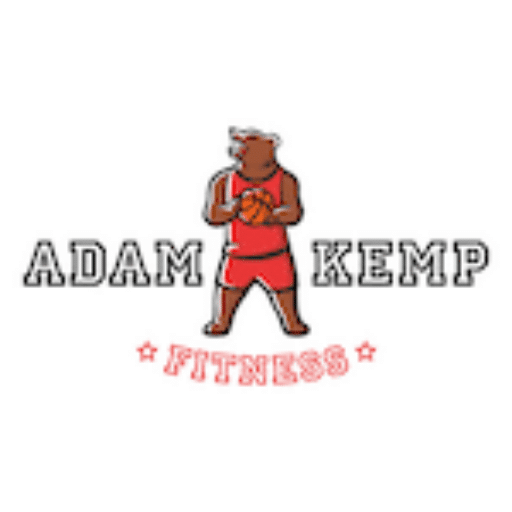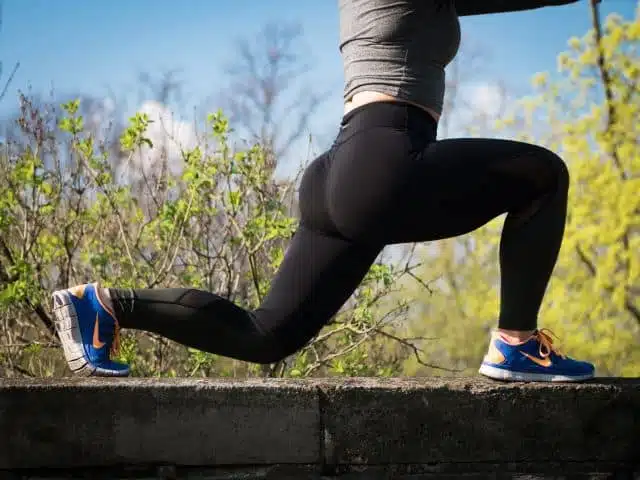Reverse Slide Lunge Exercise: Benefits, How to Do, Muscles Worked
The reverse slide lunge is one of the most functional and effective lower-body exercises for developing single-leg strength, improving joint stability, and enhancing total-body coordination.
Unlike traditional bilateral movements like squats and deadlifts, reverse slide lunges train each leg independently, addressing imbalances, improving balance, and reinforcing proper movement mechanics.
While back squats and deadlifts are essential for overall strength development, single-leg exercises are crucial because many daily activities and sports require more refined single-leg strength.
The reverse slide lunge requires you to slide one foot backward while maintaining control through your front leg, engaging the quads, hamstrings, glutes, and core with every rep.
Because of the sliding action, it minimizes joint impact and places a greater emphasis on muscular tension, making it especially valuable for injury prevention and athletic performance.
As a professional basketball player competing internationally for over a decade, I’ve consistently relied on this movement, along with other types of lunges, to protect my knees, strengthen my hips, and maintain functional mobility throughout long seasons.
It’s a joint-friendly, travel-friendly, and results-driven exercise I recommend for anyone serious about building strong, balanced legs.
Whether you’re training for sports, general fitness, or long-term health, adding the reverse slide lunge to your routine can transform how your body moves and performs.
What is the Reverse Slide Lunge Exercise?
The reverse slide lunge is a single-leg lower-body exercise that combines strength, balance, and mobility into one smooth movement.
It involves stepping one foot backward while keeping it in contact with a sliding surface, such as a glide disc, towel, or slideboard, while the front leg remains planted and performs most of the work.
What sets this variation apart from a standard reverse lunge is the continuous tension and control required throughout the entire movement.
Instead of lifting the back foot off the ground, the sliding action demands more eccentric strength from the glutes, hamstrings, and adductors, while also engaging the core to maintain alignment and stability.
The reverse slide lunge is particularly effective for developing functional leg strength, improving hip mobility, and correcting muscular imbalances, making it an ideal choice for athletes, active lifestyle advocates, and anyone focused on long-term joint health.
How to Do a Reverse Slide Lunge
How to Do the Reverse Slide Lunge Exercise
The reverse slide lunge exercise can be performed with minimal equipment and is suitable for all fitness levels. All you need is a smooth surface and a sliding tool—such as a glide disc, towel, paper plate, or slideboard—under your back foot.
Step-by-Step Instructions:
- Take the Start Position: Stand tall with your feet hip-width apart. Place one foot on a glide disc or towel and keep the other foot firmly planted on the floor.
- Engage Your Core & Initiate the Lunge: Brace your abdominal muscles and keep your torso upright to maintain proper spinal alignment. Slowly slide the back foot straight behind you, bending both knees as you lower your body into a lunge. Your front knee should remain aligned with your toes, forming a 90-degree angle.
- Control the Descent: Keep tension in your front leg while your back knee hovers just above the floor. Focus on maintaining balance and moving smoothly.
- Return to Start: Press through your front heel to engage your glutes and hamstrings as you slide the back foot forward, returning to the standing position.
- Repeat: Perform 6–12 reps on each leg, depending on your fitness level and training goals.
Here’s a video of me demonstrating the reverse slide lunge exercise at home using only glide discs on carpet:
Form Tips:
The reverse slide lunge exercise emphasizes control, coordination, and muscular endurance, making it a smart addition to nearly any strength or athletic training program.
Here are a few tips for proper form you should be contious of:
- Avoid letting your front knee collapse inward.
- Keep your torso vertical and avoid leaning forward.
- Move slowly and with intention—rushing through reps reduces the effectiveness.
Reverse Slide Lunge Muscles Worked
The reverse slide lunge is a compound movement that activates multiple major muscle groups across the lower body and core.
Because it requires both stability and strength, it not only builds muscular endurance but also enhances movement coordination.
Understanding which muscles are targeted can help you execute the exercise more effectively and maximize its performance benefits.
The primary muscles worked in the reverse slide lunge include:
- Quadriceps: The front thigh muscles are heavily engaged as they work to extend the knee during the lunge movement.
- Hamstrings: These muscles at the back of the thigh help stabilize the movement and control the descent into the lunge position.
- Glutes: The gluteus maximus is particularly activated during hip extension, helping to drive the body back up to the starting position.
- Adductors: The inner thigh muscles assist in stabilizing the legs during the sliding motion.
- Calves: The calves provide support and balance during the lunge.
- Core: The core muscles, including the abdominals and obliques, are engaged to maintain stability and balance throughout the movement.
- Hip Flexors: These muscles stretch during the backward sliding motion, helping to improve flexibility and mobility.
Reverse slide lunges provide a comprehensive lower-body workout while also developing core stability and balance.
Benefits of the Reverse Slide Lunge Exercise
The reverse slide lunge is a unilateral, multi-joint movement that provides both strength and neuromuscular coordination benefits.
Unlike bilateral lifts that may mask asymmetries between limbs, this exercise emphasizes isolated limb control, promoting better muscular balance and joint stability.
It is particularly valuable for athletes and active individuals aiming to improve lower-body mechanics, reduce injury risk, and enhance sport-specific performance.
Biomechanically, the reverse slide lunge emphasizes eccentric control and concentric power through the quadriceps, hamstrings, and gluteus maximus, while simultaneously requiring engagement from the core musculature and hip stabilizers for postural integrity.
Due to its sliding motion, this variation reduces abrupt ground contact, thereby minimizing compressive joint forces compared to more ballistic movements.
Here are a few of the most significant benefits of the reverse slide lunge exercise:
Increased Gluteal Recruitment
The sliding motion reduces momentum and increases time under tension, thereby improving gluteus maximus activation, particularly during the terminal hip extension phase.
Since many individuals exhibit gluteal amnesia or underactivation from sedentary behavior or overreliance on bilateral lifts, this movement helps retrain motor patterns for more effective posterior chain engagement.
Improved Hip Flexibility
During the reverse slide, the trailing leg experiences an active stretch through the iliopsoas and surrounding hip flexor complex.
Over time, this controlled lengthening may improve hip extension range of motion, which is crucial for functional movement patterns such as sprinting, hinging, and squatting.
Better hip mobility is also associated with reduced compensatory lumbar spine movement and lower back discomfort.
Knee Stability
The reverse slide lunge places the majority of the load on the front leg, requiring significant co-contraction of the hamstrings, quadriceps, and gastrocnemius to stabilize the knee joint.
Strong hamstrings provide stability to the knee joint, reducing the risk of knee injuries such as ACL tears and helping to alleviate knee tendonitis.
This dynamic stabilization also improves proprioception and may help reduce the risk of ligament injuries and tendinopathies, especially in athletic populations prone to knee stress.
Increased Running Speed
Hamstring strength, particularly eccentric strength, is a key factor in sprint performance and injury prevention.
The reverse slide lunge improves this by requiring controlled deceleration during the slide phase and powerful re-acceleration during the return.
Athletes seeking to improve linear speed or deceleration ability will find this movement particularly beneficial.
Better Movement Quality
Because it trains multiple planes of motion and reinforces joint alignment, this exercise improves movement quality and motor control.
Individuals with poor coordination or muscular imbalances may experience improved gait, squat patterns, and general kinetic chain function after consistent practice.
Versatile and Portable
One of the practical advantages of the reverse slide lunge is its adaptability.
It can be performed in limited space using simple equipment, such as sliders, towels, or furniture pads, making it ideal for home workouts, working out while traveling, or minimalist training environments.
This accessibility supports exercise consistency and adherence to workout programs, which are crucial for achieving long-term results.
Last update on 2025-07-08 / This article includes affiliate links/Images via Amazon Product Advertising API. I may earn commissions on purchases made through these links.
How Often Should You Do Reverse Slide Lunges?
The optimal frequency for performing reverse slide lunges depends on your training experience, recovery capacity, and specific goals.
As a unilateral, compound movement, this exercise places moderate stress on the neuromuscular system and should be integrated strategically into your weekly programming.
General Guidelines:
- Beginners: 2–3 times per week on non-consecutive days is sufficient to build foundational strength, improve motor control, and avoid excessive fatigue.
- Intermediate to Advanced Trainees: 3–4 sessions per week may be appropriate if you’re rotating movement variations or emphasizing different training loads (e.g., bodyweight, dumbbells, tempo reps).
- Athletes in Season: 1–2 times per week may suffice to maintain lower-body strength and mobility without compromising recovery or performance in games or practices.
Key Considerations:
Incorporating reverse slide lunges consistently, while respecting your body’s recovery needs, can yield long-term improvements in strength, balance, and athletic movement patterns.
- Volume and Intensity: If you’re performing multiple sets close to failure, limit frequency to allow for full recovery. For lighter, mobility-focused reps, higher frequency may be tolerated.
- Training Split: Integrate reverse slide lunges into leg day, functional training sessions, or movement quality workouts depending on your program structure.
- Recovery: Monitor for delayed onset muscle soreness (DOMS), especially in the glutes and hamstrings. If soreness persists beyond 48 hours, reduce frequency or intensity.
Differences Between Reverse Lunge and Reverse Slide Lunge
Although the reverse lunge and reverse slide lunge appear similar at first glance, their biomechanics and muscular demands differ significantly due to the presence or absence of a sliding surface.
| Feature | Reverse Lunge | Reverse Slide Lunge |
|---|---|---|
| Motion Type | Step-back | Gliding slide |
| Impact Level | Moderate | Low |
| Muscle Activation | Balanced | Emphasized posterior chain |
| Stability Demand | Dynamic balance | Isometric control |
| Joint Stress | Higher (especially knee/ankle) | Lower |
| Equipment Needed | None | Slide disc or towel |
Ground Contact vs. Gliding Motion
In a standard reverse lunge, the rear foot is lifted off the ground and stepped backward, requiring greater coordination and dynamic balance.
This movement generates a brief impact when the back foot contacts the floor, which can stress the knee or ankle in some individuals—especially if form is compromised.
By contrast, the reverse slide lunge uses a continuous gliding motion, allowing for smoother transitions and more controlled eccentric loading.
This reduces joint impact while increasing time under tension, especially for the glutes, hamstrings, and hip stabilizers.
Stability and Muscle Engagement
Traditional reverse lunges challenge overall balance and proprioception, particularly in free-weight or bodyweight variations.
However, the reverse slide lunge demands greater isometric stability from the core and front leg, as the sliding limb is less involved in weight-bearing and more involved in controlled deceleration.
Because the sliding action limits momentum, the reverse slide lunge often leads to higher muscle activation in the posterior chain and can more effectively isolate movement in the sagittal plane.
Joint Stress and Accessibility
For individuals with joint sensitivity or limited mobility, the reverse slide lunge can be more joint-friendly due to its reduced impact and smoother motion.
It’s also easier to scale for beginners or those in rehabilitation settings.
Final Thoughts: Is the Reverse Slide Lunge a Good Exercise?
Yes, the reverse slide lunge is not just a good exercise; it’s an exceptionally effective tool for building functional lower-body strength, improving movement quality, and supporting joint health.
Its low-impact, high-control design makes it accessible to beginners while still offering enough progression potential for advanced trainees and athletes.
Because it trains the body unilaterally, the reverse slide lunge helps correct muscular imbalances that often go unnoticed with bilateral movements.
It also challenges stability and coordination, engaging the core and supporting muscles in ways that improve both athletic performance and daily movement patterns.
Whether you’re recovering from an injury, trying to prevent one, or simply looking to upgrade your lower-body training, the reverse slide lunge offers unmatched versatility and value as part of a well-rounded fitness program.
Once you’ve mastered the traditional reverse slide lunge, challenge yourself further with these five reverse slide lunge variations designed to develop strength, mobility, and athletic performance.
This website does not provide medical advice. This website site does contain affiliate links, and purchases may earn a commission.
Read my Medical Disclaimer, Review Disclaimer, and Publishing Policies for more details. Use of this site indicates acceptance of these terms.




